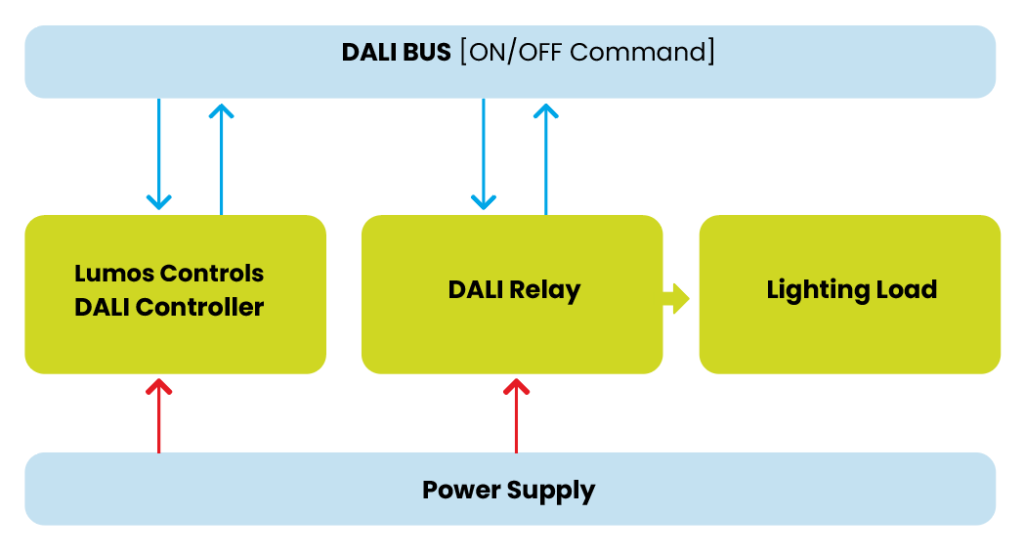DALI Relay: How it Works and Why it is Important

As you know, DALI is a widely used protocol in the lighting industry for controlling and managing lighting systems. However, non-controllable luminaires within a lighting system can lead to inefficient energy usage and difficulties in achieving desired lighting effects. This is where DALI relays come in.
DALI relays are an essential component of DALI lighting systems, that allow for the control of loads such as light fixtures, fans, blinds, shutters, curtains, motors.
Incorporating DALI relays into your lighting system can expand functionality and enable you to achieve greater control over your lighting environment. In this blog, we will explore how DALI relay enhances the energy efficiency and reliability of your commercial lighting applications.
This blog covers;
- What is DALI relay?
- DALI Part 208
- Benefits of DALI relays
- How does DALI relay work?
What is DALI Relay?
A DALI relay is a device that enables the control of individual or groups of lighting fixtures through a digital signal. They are often used in conjunction with DALI components, such as DALI sensors, controllers, and ballasts, to create a fully integrated lighting control system. These relays come in various form factors, including standalone devices that can be installed in remote locations and devices that can be built into lighting fixtures or junction boxes.
Why DALI relay?
Here are some benefits of using DALI relays in lighting control systems:
- Energy Efficiency: DALI relays can help reduce energy consumption by precisely controlling loads.
- Scalability: Can be easily integrated into existing DALI lighting systems, making it easy to add additional lighting loads or reconfigure the system as needed.
- Flexibility: They can be used to control a wide variety of lighting loads, including incandescent, fluorescent, LED, and other types of lighting.
- Cost-effective: DALI relays are digital and use a single bus to connect multiple devices.
DALI Part 208 for relays and switches
The DALI Alliance, also known as DiiA, has expanded the DALI-2 certification program to cover control gear that functions as switches and relays in Part 208. This standard defines the requirements for devices that can be used to switch and control lighting loads within a DALI system.
Part 208 devices are typically used to switch loads ON or OFF without dimming. They are commonly used with non-controllable luminaires to enable them to turn ON and OFF as part of a lighting control system. They can also be used to switch other types of loads, such as motors, actuators, blinds, shutters, or curtains.
How does DALI relay work with Lumos Controls DALI Controller?
DALI relays typically connect to a DALI bus, which is a two-wire digital communication network that links all DALI-compatible devices in a lighting system. A DALI controller or other DALI-compatible devices, such as sensors or switches, can control DALI relays as they are programmed with a unique address on the network.
If you want to connect loads such as lighting or non-lighting devices to our Lumos Controls ecosystem, you can integrate DALI relay from vendors. Our Lumos DALI controllers are equipped to communicate with these DALI relays through the DALI bus, allowing you to control the ON/OFF operations of the loads connected to them.

As shown in the figure, let’s say you have a Lumos Controls DALI controller that is connected to your DALI network.
You want to turn on a specific light, for instance a decorative chandelier, which is connected to a DALI relay.
The controller sends a signal over the DALI network to the DALI relay, telling it to turn on the lights.
When a signal is received from DALI controller, the DALI relay activates its internal switching circuit, which allows the flow of current to the load. This causes the light to turn ON. Similarly, when the signal is removed, the relay deactivates the switching circuit, cutting off the flow of current to the lighting load, causing the light to turn OFF.
Note: While our blog post explains how our DALI controller can be integrated with a DALI relay, we want to inform our readers that this feature is currently in development and will be available soon.
Conclusion
As the demand for energy-efficient lighting solutions continues to grow, the role of DALI relays is becoming increasingly important. With their ability to control lighting levels and reduce energy consumption, DALI relays will undoubtedly continue to play a key role in delivering efficient and sustainable lighting solutions for commercial and industrial applications.
Want to learn how to optimize your lighting control with DALI relay? Feel free to contact our lighting experts.